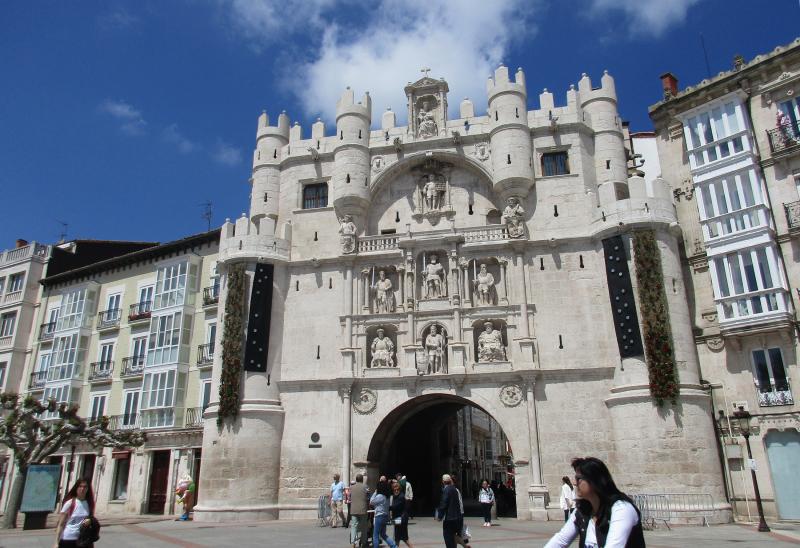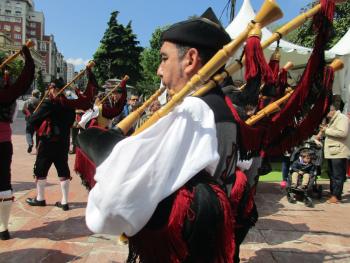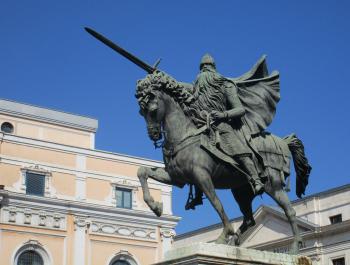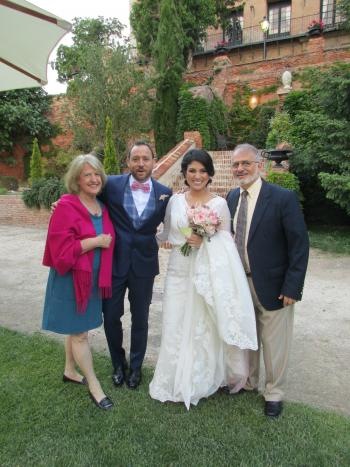An independent exploration of Spain, plus an English-language-immersion program that offers great benefits
This article appears on page 20 of the March 2019 issue.
An invitation to a friend's wedding outside Madrid at the end of May 2018 morphed into a month long trip to Spain, including visits with two other Spanish friends and some fantastic travel discoveries.
Suitcases packed, tickets in hand and our Spanish-language courses refreshed, off we went to see tres amigos (three friends).
Getting there
Our "itinerary" — we prefer serendipitous travel to organized tours — would take us to places we had never visited as well as to some familiar ones.
It also had been many years since our last experience with VaughanTown, an English-language-immersion program in which volunteers spend a week conversing with Spaniards who want to improve their English-language skills in exchange for accommodations, three meals per day and transfers from Madrid. So we registered for a program in a remote location near the city of Zaragoza.
We also took a look "just around the corner" in the Principality of Asturias.
After two days of complex travel from the US via car, plane and train, we arrived in the beautiful mountain region of Asturias in northern Spain. Even in May, the mountains were capped with snow.
The regional capital of Oviedo became a terrific base for us to spend just under a week.
Following our flight to Madrid from the US, we left in the late afternoon by train, traveling north through the flat, green landscape. Overcome by jet lag after our long transatlantic flight, we fell asleep but were jolted awake on the winding journey through the stunning Cordillera Cantabrica mountain range, with its jaw-dropping peaks and valleys, arriving in Oviedo just before sunset.
Our wonderful accommodations, Hotel NH Oviedo Principado ($80 per night, booked online), were perfectly located right in the center of town and offered us a comfy and welcome long night's rest.
Oviedo
Oviedo is a buzzing, vibrant city (population 200,000-plus) with elegant parks, pretty plazas and varied architecture dating from the Middle Ages to modern times.
Unlike much of the rest of the country, this area was never part of Moorish Spain. As we were enjoying wonderful coffee and Oviedo pastries for a late breakfast on our first day, we heard bagpipes and saw, rushing out of the Confiteria Rialto, a city landmark, a colorful procession with bagpipers — not surprising, since Asturias was Celtic territory, like neighboring Galicia before the arrival of the Romans.
At the handicrafts market nearby, everyone was out in their Saturday best on a gorgeous spring day, and there the entertainment continued, as dancers in colorful traditional costume performed with the pipers.
No sooner had that finished than a large, noisy (and, thankfully, peaceful) demonstration took place on the main street, with people of all ages (and their dogs and babies) protesting against "Band-Aid" fixes to their pensions.
Wandering around at leisure, we felt as if we were the only tourists in a town void of frequent tour groups, and our long-practiced Spanish certainly added to our comfort.
We admired dozens of the beautiful old statues and the modern sculptures in the city, including one by Colombian artist Botero that we recognized instantly from our trip to Colombia a few years before. There was even one of Woody Allen, who filmed parts of the movie "Vicky Cristina Barcelona" there in 2008.
For something different, we popped into a bar for a tipple of local cider, the region's most famous specialty, poured, with flourish, by the barman with his arm raised some 3 feet above the glass.
Gijón and Avilés
With Oviedo as a perfect base for two different one-day excursions, we headed out of town on a short bus ride through the lovely, green Asturian countryside.
Once a grimy industrial port, Gijón, on the Bay of Biscay, is the largest city in Asturias. While its delightful pedestrianized streets, plazas, parks and seafront walk of today made for easy exercise, the steep, narrow streets of the Old Town promontory of Cimadevilla gave us a more rigorous cardio workout, but we were rewarded with spectacular sweeping views from the top of the headland.
We concluded our visit to Gijón with the indulgent Spanish favorite of churros and rich drinking chocolate.
Of great interest to us as Floridians was our next stop, the small city of Avilés, the birthplace of Pedro Menéndez de Avilés, founder of the city of St. Augustine, Florida.
When the steel industry was in full swing in Asturias in the 1950s, the deepwater port of Avilés had the dubious distinction of making the city one of Europe's most polluted! Now cleaned up, Avilés has a very attractive, compact Old Town, and it reminded us of neighboring Galicia. The glass-galleried buildings and colonnaded streets were full of elegant boutiques and gourmet food shops.
Across the river is the Centro Niemeyer, the site of cultural events and exhibitions that some call the cultural rival to Bilbao's Guggenheim Museum.
Back in Oviedo, we spent our last full day there enjoying the city at leisure.
After a nice breakfast at our favorite café, Confiteria Rialto, we headed into Oviedo's Casco Antiguo (Old Town) for more discoveries. Beautiful plazas, historic buildings, boutiques, the main food market and shops focusing on Asturian artisanal specialties all were a delight.
And on the edge of this area, we found a small plaque on the side of Oviedo's main theater informing us that a Jewish cemetery once lay underneath — the only hint of any Jewish life there that we found.
Later, after a siesta, we headed to the tranquil Campo de San Francisco, Oviedo's clean and green public park, for a stroll. This is really an exceptional small city!
It was time to say farewell to Asturias and travel south by train to Valladolid.
Valladolid
While we had visited Valladolid twice before and extensively explored the city and surrounding area, this was a special return visit to spend a couple of days with a good friend, whom we had met some eight years before at an English-language program. This time, we were generously invited to stay in her modern, spacious apartment in a residential neighborhood.
The warm welcome we received at the railway station, with lots of hugs and kisses all around, and the quality time we spent with her were priceless.
Our friend had to work during the day, so we did a bit of sightseeing on our own, using the local bus and our feet. The weather was cool and sunny as we retraced our earlier steps to several churches (there are dozens!) and the soaring and stark cathedral, wandering down the busy, narrow streets of the Old Town that led to impressive plazas.
We also grazed our way through tempting selections at the magnificently restored Mercado Municipal.
After a wonderful visit with our friend, we returned to Madrid for the next chapter of our great Spanish adventure.
VaughanTown
After more than five years, we decided to, once again, participate in a 6-day-long English-language program for Spaniards with a company called VaughanTown (Madrid, Spain; grupovaughan.com/teaching-english-spain), held at a "surprise location."
After a nice tapas reception in Madrid on a Saturday evening, we boarded our chartered bus the next morning for the trip.
The previously undisclosed location for the program turned out to be the Balneario Sicilia, a historic, luxury thermal baths and spa resort in the mountains of the province of Aragon, an hour outside the city of Zaragoza. The remote location, next to the tiny village of Jaraba, was perfect for daily walks during our conversations.
The dramatic scenery, with deep, steep granite chasms and pristine, clear waters from the mountain springs nearby, was vastly different from what we had seen in the rest of Spain. In fact, Romans knew of the curative powers of these waters and built bridges in the vicinity as early as 70 BC!
We had so much fun at VaughanTown, meeting, laughing and dining with people from all over the world. It was amazing how, in such a short time, we grew very close to over a dozen Spaniards from many parts of the country while enjoying this luxury resort at no cost to us!
Our time at VaughanTown seemed to fly by. Multiple long walks with our new Spanish friends to the quiet old village of Jaraba and past the fresh mountain streams teeming with trout, watching baby goats (their bells ringing) gamboling across the bright green fields and finding narrow and steep streets to stretch our legs made for memorable days.
At the end of each day, hilarious skits, with everyone roaring with laughter, relaxed all of us before dinner at 9. Yes, the Spanish do eat later than most of us!
We enjoyed the resort's soothing, mineral-rich thermal pools, located in a dramatic cave setting. We both felt 20 years younger afterward!
The hotel staff, who pampered us, provided excellent service, and the multicourse meals, with endlessly flowing wine, were so substantial that we couldn't finish them.
We concluded our program having formed bonds of friendship with our fellow participants. With lots of hugs and kisses back in Madrid, we said farewell to all. It had been an experience so delightful that we wondered why it had taken us so long to repeat it.
Segovia
For our third visit to the historic jewel of Segovia, we were warmly greeted by our dear friends (whom we had met at our first VaughanTown program years before) at the railway station, then we were whisked away to their "estate" nearby for a weekend stay. We had to switch our brains over from the intensive English of VaughanTown to intensive Spanish; our language skills were certainly put to the test!
Although we had previously toured Segovia, this time we explored the "newly restored" former Jewish Quarter. Segovia now welcomes throngs of visitors to the First Main Synagogue (now a church) as well as to its residences, new shops and a Sephardic restaurant and bakery. We thought this Jewish Quarter surpassed that of the more famous, well-visited Toledo.
There were so many shoulder-to-shoulder visitors in town that Segovia's Old Town felt a bit like Disneyland. Its famous Roman aqueduct continues to be the city's main attraction. Many of its buildings (city walls, cathedral, Alcazar and aqueduct) are lit up in dramatic and colorful displays at night. Our hosts showed us all of this on a drive through the narrow, winding streets while their car just barely missed scraping walls.
A Sunday excursion by car to the picturesque hill town of Sepúlveda, an hour outside Segovia, took us through dramatic mountain scenery with panoramic views over chasms and a river, rivaling views of Arizona's Grand Canyon.
The little town was filled with Spanish travelers, many from Madrid. Lunch featured huge servings of roast lamb, a specialty of the region.
We had a fabulous, warm Segovia experience, especially enjoying the privilege of spending quality time with dear friends.
Burgos
One of the main stops along the French route of the well-traveled Camino de Santiago (Way of St. James), Burgos is a busy, vibrant city that we had not previously discovered.
Our taxi driver's first question to us was, "Are you pilgrims?," reflecting the large number of people walking this route. At the same time, Burgos is one of Spain's historically important cities; this was Franco's capital-in-waiting during the Spanish Civil War.
We spent most of our time in the Old Quarter, where our Hotel Norte y Londres (about $60 a night, booked online) was conveniently located right on the Camino. Our only complaint about this comfortable hotel was that their Internet connection was woeful, so we took our laptop across the street to a bar that offered free, high-speed Wi-Fi.
A quick look at most of the important sites on the little red tourist train (Chu-Chu Tren), which shuttled visitors around town, showed us many monuments and the remains of the castle (destroyed by Napoleon's army in 1813), from where we had sweeping views of the city. Our own in-depth exploration followed.
The UNESCO World Heritage-listed cathedral is the crown jewel of Burgos. A magnificent masterpiece inside and out, it houses many ornate chapels and numerous tombs of bishops, royalty and other important people. (Its most famous tomb is that of the 11th-century heroic mercenary Rodrigo Díaz, better known as El Cid.)
The latest addition to the city is the superb Museum of Human Evolution (free admission for seniors), part of a sprawling, 3-building complex. We spent several hours at this glistening, modern museum marveling at its excellent interactive displays.
Opposite our hotel in Old Town, the magnificent palace housing the Military Museum (free entry) contained exhibits detailing Spain's checkered military history. Lucky for us, there was a special exhibition that allowed us to view the entire interior of this spectacular building, parts of which are rarely open to the public.
Also of particular interest in Burgos was the massive, 12th-century Monastery of Santa María la Real de Las Huelgas (admission, €6, or about $7), one of Spain's most important. Currently home to some 30-plus nuns, the monastery also houses many treasures, Flemish tapestries and the tombs of Spanish royalty, including that of the daughter of the remarkable Eleanor of Aquitaine (the mother of Richard the Lionheart) and her husband, Alfonso VIII of Castile.
Dining in Burgos was a pleasure, as there were many restaurants, cafés and tapas bars in the Old Town, along the Camino. In addition to the huge variety of tapas served at numerous bars, we discovered raciones, meal-sized portions of tapas. All were creative, delicious and economical.
Most restaurants offered "daily menu" lunches — three courses with a full bottle of wine — which were a good value (E8-E10). If that wasn't enough to satisfy one's appetite, exquisite pastries and killer cakes to tempt the most disciplined could also be found. No wonder Burgos was Spain's Gastronomic Capital in 2013!
It was time to head back to Madrid and to the TRYP Madrid Chamartín Hotel ($85 per night), located across the street from the Chamartín RENFE train station, convenient for our travel to and from Madrid.
A grand finale
Some eight years ago, during our first VaughanTown program, we befriended a delightful young man from Madrid, and we later visited each other's home. Now we were honored to be invited to his wedding, the main reason for this trip to Spain.
While the day began with wild thunder, lightning and heavy rain, by late afternoon the sun came out, offering a splendid setting for the occasion at the 18th-century Palacio de Aldovea, now a magnificent venue for receptions and weddings outside Madrid.
There was lots of glitz, glamour, laughter, warmth, loud music and even a surprise from the Peruvian bride, who had arranged for a traditional dance group to entertain after dinner.
When we left "early," at 2 a.m., with some other guests, the party was still going strong!
Unlike many other trips, on this one the focus was our warm connections with our dear friends. Indeed, we find the Spanish character to be very special.
Filling in the gaps between our arrival in and departure from Spain with travels to areas previously unknown to us was enjoyable, educational and enlightening.
Our frequent use of the efficient Spanish rail system made all this "getting around" a breeze. Additionally, our improved skills in Spanish helped, too — not everyone speaks English there!
It was a memorable great adventure.




